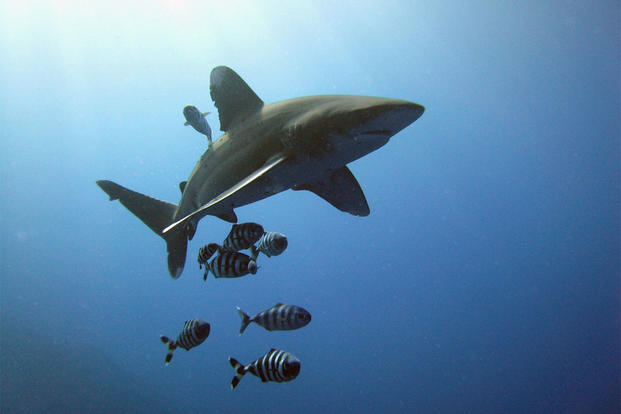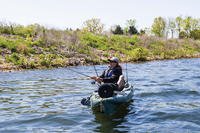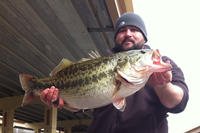It was a gray, slick-surface morning that had started out unbearably hot and sticky, even for near-shore Georgia. But it was a perfect setting for dead-drift saltwater fishing.
Charter Captain Greg Hildreth of Brunswick looked left and right along the southeast coast. He took careful note of the current and tide, then declared the spot off Cumberland Island was just right to put out baits and chum a bit.
We were looking for tarpon, trying to locate the first silver kings for friends Jake Markris and Kevin Olmstead, visiting from their homes in Fairhope, Ala. On board, too, was my son, Matt, taking a break from college studies. He was also a longtime tarpon addict.
We’d only been fishing a short while, with a couple of whole, dead menhaden baits trailing astern amid chunks of cut fish chum. Suddenly the water burst in an oversize boil at the surface, then there was another and another. Everyone was up, tense and standing beside rods with baits trailing back 50 yards from our 24-foot center-console boat.
Then a rod bowed sharply under the weight of a big fish. Jake was immediately on it, pulling it from the gunnel holder and setting the hook hard a couple of times. The fish bulldogged away, fast and straight; so powerful it slammed Jake’s knees against the side of the boat as he frantically put on a rod belt.
Before Jake could settle into a comfortable fight, a second rod bowed, and Kevin was soon hooked up to another drag-screaming fish.
Ten minutes into their fights neither fish had jumped like tarpon should, and I broke the news to Jake and Kevin.
"Probably sharks, guys, not tarpon," I told them.
"Man, I don’t know what this is, but it’s big, strong and I’m gonna get it to the boat," Kevin growled as he put heavy rod power to his invisible adversary.
A short while later Kevin drew a 75-pound blacktip shark to the boat, where Greg handled it and unhooked it. That was quickly followed by Jake’s fish, a blacktip of similar size. Soon they were laughing and high-fiving, glad for the hard fight and ready for another go at some sharks. And that’s exactly what we got that day—many times over.
Jake and Kevin each caught a tarpon that morning, nice fish that jumped and ran and fought tough and well. But it’s the sharks we all remember most. We caught sharks until our arms ached. They were blacktips and spinners that slammed jigs and jumped at least as well as our targeted tarpon. Then we caught hammerheads and small bonnetheads, with Atlantic sharpnose and duskys. We even saw a small tiger shark at the surface, but it refused a lure.
That’s how it is with sharks. They’re big and powerful, and while they don’t draw the attention and raves of more glamorous game species, they’re hard-fighting fish that can be counted on to make a showing almost anywhere in the saltwater South. Even when you’re not looking for Dixie sharks, as we weren’t that day off Brunswick, Ga., they have a habit of showing up.
One dawn last spring, for example, I was looking for seatrout near Destin in the Florida Panhandle. I was with my oldest son, Eric, and two of his pals. At first light we pulled into a little protected bay. The surface was popping with baitfish and predators. I fired a long cast with a Heddon Zara Spook, started a snappy retrieve and instantly snagged a 3-pound bluefish. In less than a minute all four of us were dancing topwater plugs across the surface. The water was roiling with leaping bait, frenzied predators and strong, fast bluefish.
We were having a ball with the blues, but about 30 minutes into the action one fish I had hooked suddenly went nuts. The bluefish was jumping and racing, acting as if its life was on the line. That’s when I saw the dorsal fin of a 6-foot bull shark closing fast. It was all I could do to pull the blue into the boat to avoid losing it to the shark.
Soon more sharks made the scene, and before the morning was over, we’d lost a dozen blues to sharks, as well as a bunch of surface plugs. We didn’t have the heavy tackle or wire leaders to handle them.
Lines were parted. Reel spools were stripped. Tackle boxes remained open and half-empty, their contents spent on the marauding, toothy fish. There even were a couple of busted rods from the melee. Blood from bluefish, sharks and our fingers peppered the decks. It was one of the most exciting and memorable fishing trips I made last year.
Top Fighting Sharks
Of all the sharks that swim Southern seas, none is more game or more highly prized than a mako. Scientists report that no other fish is faster than a mako, as it dines on speedy species such as mackerel, tuna and billfish (especially swordfish). The lightning speed of the mako, coupled with its aggressiveness and propensity for jumping, make it the premier shark of the South. Moreover, they’re big, with some of them weighing more than 1,000 pounds, though 200-pounders are more common.
Makos are not a common shark, however, so seldom do anglers (especially in the South) fish expressly for them. Most are caught by trollers after pelagic species such as marlin or wahoo, or by shark fishermen seeking whatever species that comes along. However, knowledgeable anglers who suddenly see a mako at the surface and recognize what it is, can occasionally work the fish with some success. Also, many night fishermen after swordfish commonly set out shark baits in hopes of hooking makos.
Two of the most sporting and abundant sharks are spinners and blacktips. These sharks can be caught by trolling, chumming, blind-casting, sight-casting; and inshore, offshore, over reefs and on the flats.
They’re found throughout southern coastal waters and are great light-tackle targets. Both species hit surface plugs, streamer flies and poppers, as well as jigs, sinking lures and, of course, natural baits. They jump and spin and run like unleashed piscatorial demons. And commonly found at weights between 50 and 100 pounds, they can offer quite a fight.
It’s difficult to distinguish blacktips from spinners, since both species are similarly shaped and have blacktip fins. Many light-tackle anglers, though, could care less. Both species are a joy to catch, and they’re available in the warm months to millions of Dixie anglers.
Deep Runners
After the mako, blacktip and spinner, few other sharks jump. Instead they dog it out, sticking to the depths, which requires heavy tackle. Among these deep-runners, most often caught with natural bait, are the tiger, hammerhead, dusky, sand, lemon, bull and sandbar sharks. Among this group, the bull, tiger and hammerhead are especially noteworthy because of their massive size, as well as their well-known reputations as man-eaters.
A tremendous 1,780-pound tiger shark was caught off South Carolina in June 1964 by Walter Maxwell. This catch ranks as one of the most incredible of all time since Maxwell made it from the Cherry Grove fishing pier near Myrtle Beach using a 16/0 fishing outfit, which held 1,400 yards of 130-pound test line. A whole skate (similar to a stingray) was used for bait, and the massive fish leapt twice despite its incredible bulk during the 41⁄2-hour battle. The shark made more than 30 runs, some up to three-quarters of a mile long.
The fish was not weighed until 15 hours after it was caught, and many estimates are that the shark lost 10 percent of its body weight in that time. The tiger had a 103-inch girth and measured 13 feet, 11 inches long. Incredibly, Maxwell hooked, played and then lost another tiger just a few days earlier that he and friends insist was much bigger than he one he caught, which remains an all-tackle record.
Like tiger sharks, hammerheads are also notoriously aggressive, and several different species of these sharks can be caught in the South. The great hammerhead is the largest, and can grow up to 18 feet, with 12-footers common. While many sharks are quite shy, hammerheads are not, and have a decided preference for live bait intended for other species like king mackerel or sailfish. Hammerheads also regularly dine on 100-pound tarpon. It takes a pretty good shark to sever a giant tarpon with a single bite. But it happens wherever tarpon congregate—like Boca Grande Pass during the May-June tarpon migration.
It’s there that charter captain Bucky Dennis set the all-tackle world record for hammerhead in May 2006. That 14-foot shark weighed 1,280 pounds, but Bucky says much bigger hammerheads are there.
"Oh, there are 18-footers in the pass, which would weigh close to a ton," he says. "Tarpon fishermen see them all the time there, eating the tarpon."
Bucky likes fishing incoming tides in the morning. Almost anything big and alive can be used for hammerhead bait, with jack crevalle and stingrays as good choices. He doesn’t chum, and he uses no lead to get baits deep. Baits are simply free-lined in current, and only single hooks are employed. Double hooks are too dangerous when manhandling giant sharks boatside.
But this is a specialized sport, and shark fishing for most anglers is not this heavy-duty nor sophisticated. It’s usually light-tackle action primarily for blacktips, spinners, bulls and lemons. That’s good for plug, spin and fly fishermen, since such sharks are typically in the 30- to 80-pound range, with occasional fish weighing more than 100 pounds.
Catching sharks isn’t quite the same sport as jumping tarpon or sight-casting to cobia. But sharks are plenty strong, and some species jump. On reasonably light tackle, casting baits or lures to feeding sharks makes your knees knock and your palms sweat—and that’s usually good enough for most anglers.
Shark Conservation
Sharks have almost always been abundant in the South. In fact, 25 years ago, many area tarpon and kingfish anglers disdained sharks for getting in the way of fishing for more desirable species. Tarpon fishermen that drifted and chummed commonly would catch a dozen or more sharks that took baits intended for silver kings. Then about 10 years ago sharks suddenly became scarce. Anglers noticed sharks were almost gone from the area. Only an occasional small blacktip or spinner was seen by tarpon or kingfish chum fishermen in an entire day.
The culprit was overfishing, chiefly by commercial shark netters and longliners working near-shore waters.
State regulations have pretty much halted that, with very strict laws imposed on shark harvest (generally, two per boat, per day, but check current state and federal size and species regulations). Federal shark fishing rules for out-of-state waters also have helped the region’s shark fishery, to the point that 10- to 100-pound sharks are back in abundance. The fishing is so good that it’s the most sure thing a near-shore angler can do to bend double a heavy rod.—B.M.
Seek Out Shrimp Trawlers
Shrimpers usually trawl all night, clearing their nets and anchoring sometime in the morning. For this reason some of the best sharking in the South is had at dawn through midday.
The top technique is to locate a group of trawlers, then run to those surounded by excited gulls and terns, which are drawn to boats as the crews haul their nets up from the deep. Casts made behind boats when "by-catch" is tossed overboard is almost sure to bring instant hook-ups. Tarpon, cobia, king mackerel, big jack crevalle and little tunny are boated regularly, as well as sharks.
It helps to have quality binoculars on board to scan the horizon looking for trawlers hauling up their catch. But even when action is slow, anglers can still get into sharks by casting baits behind a trawler just dragging deep nets. Sharks and other fish species regularly follow trawlers, knowing that sooner or later something edible is likely to fall overboard or pop out of the nets.
While all shark fishing behind trawlers is exciting and reliable, the best action is when the creatures are abundant and extra hungry. This often occurs early in the season, usually in May, when bait stocks are not yet plentiful and trawlers are the quickest way for sharks to belly up to the dinner table. Sharks are usually so ravenous that surface chugger plugs and streamer flies score nearly as well as natural baits.
Once, off Fernandina Beach, Fla., friends and I went out to check shrimp trawlers and the first boat we found had already pulled its nets. Oddly, there wasn’t much bird or porpoise action around its stern. Three crew members were kneeling on the deck near the trawler transom when I cast a fly-rod popping bug into the boat’s prop wash. I chugged it a time or two and a huge, 100-pound spinner shark shot up from the depths, clamped onto the bug and continued up-and-airborne to eye-level of the men picking through their catch on the back of the boat.
For a second I thought the shark was going to land in their laps. But, fortunately, it spun off to one side and fell back into the sea with a resounding smack.
It takes a lot to get a hard-working, weary seaman to acknowledge surprise. But those three guys were noticeably shaken. One even turned his head and saluted me. I returned the gesture and I went back to fighting the shark, one of many we boated that day on bugs, plugs, flies and jigs.—B.M.
















